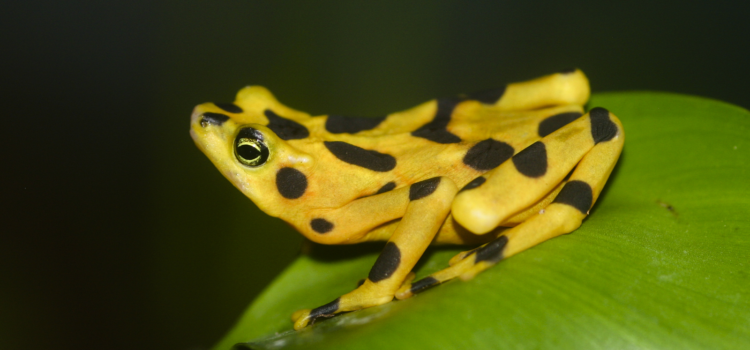

This article is an excerpt from the Shortform book guide to "The Sixth Extinction" by Elizabeth Kolbert. Shortform has the world's best summaries and analyses of books you should be reading.
Like this article? Sign up for a free trial here .
What happened to the Panamanian golden frog? What is the reason for its disappearance?
Panamanian golden frog was once common in the village of El Valle de Anton in central Panama, where it was considered a symbol of luck. The frogs could easily be seen and heard in the hills around town. Then they started disappearing.
Read about the Panamanian golden frog and what caused its disappearance.
What Happened to the Panamanian Golden Frog?
Panamanian golden frog, native to the rainforests and higher-elevation cloud forests of western-central Panama, is less than two inches long and is bright yellow with dark brown spots. Their bright color warns of their extremely toxic skin—a single frog contains enough poison to kill twelve hundred mice.
An American graduate student studying the golden frogs in western Panama went back to the U.S. to write her dissertation—and when she returned sometime later to her study area, she couldn’t find any frogs at all. She set up a new study area farther east, where she found some frogs; at first, they seemed healthy and then they, too, vanished.
By 2002, there weren’t any golden frogs left to the west of El Valle; in 2004, dead frogs were seen in the village of El Cope, close to El Valle. Something was causing the population to crash. Concerned biologists in the U.S. and Panama decided to try to save the species by capturing some and raising them indoors at a small facility named the El Valle Amphibian Conservation Center (EVACC).
Frogs disappeared not only from populated areas, but also from untouched areas like the Sierras and the mountains of Central America. In central Costa Rica, rare species, as well as common ones, were vanishing. In Ecuador, a backyard toad disappeared in just a few years. Northeastern Australia’s most common frog, the southern day frog, also disappeared.
The Culprit Discovered
Similarly, at the National Zoo in Washington, D.C., blue poison-dart frogs, which the zoo was raising, began dying. A pathologist found a fungus on their skin belonging to a group known as chytrids. Chytrid fungi are common, but this was a species never seen before. The fungus, which was named Bd (Batrachochytrium dendrobatidis), was raised in a lab and tested on some blue frogs—they died. Researchers discovered that Bd keeps frogs from properly absorbing electrolytes through their skin that are needed for heart function.
The fungus can continue to live on after it has killed all the frogs in an area, which means that if frogs bred successfully in captivity—including the golden frogs at the EVACC in Panama—were released back into the wild, they’d die. Researchers at the center still hope to release them back into the forest someday, but no one knows how it could be done successfully.

———End of Preview———
Like what you just read? Read the rest of the world's best book summary and analysis of Elizabeth Kolbert's "The Sixth Extinction" at Shortform .
Here's what you'll find in our full The Sixth Extinction summary :
- How humans have set in motion a sixth mass extinction
- The 5 mass extinction events that occurred over the last 500 million years
- Why human ingenuity might be able to save the human species from extinction






